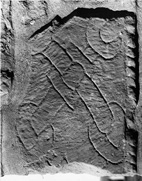Select a site alphabetically from the choices shown in the box below. Alternatively, browse sculptural examples using the Forward/Back buttons.
Chapters for this volume, along with copies of original in-text images, are available here.
Object type: Part of cross-shaft
Measurements: H. 48 cm (19 in); W. 37 cm (14.5 in); D. 20 cm (7.9 in)
Stone type: Medium-grained red sandstone (St Bees sandstone)
Plate numbers in printed volume: 469
Corpus volume reference: Vol 2 p. 133
(There may be more views or larger images available for this item. Click on the thumbnail image to view.)
Slab-like shaft. A cable moulding survives on the right side of the only visible face. The decoration is incised and consists of two rows of widely spaced, rounded Stafford knots whose connecting crossing strands are enclosed by a diamond-shaped 'tie'. Traces of a second tie can be seen at the bottom of the stone.
Though the knot pattern is a popular one in Northumbrian sculpture the Millom combination with a diamond-shaped tie is unique. The same knot, without a tie, but treated in a similar incised fashion and also exploiting the effects of open ground, is found again across the Solway at Craiglemine, Wigtownshire, where it is associated with stopped-plait typical of the type found around Whithorn in the tenth century (Allen 1903, fig. 512). Whithorn itself provides another parallel for Millom's scale, open ground and uncertain drawing but with a different form of knot (Allen 1903, fig. 525). Diamond 'ties' were popular in Viking-age sculpture on the Isle of Man, where they reflect a long-established Scandinavian taste.



